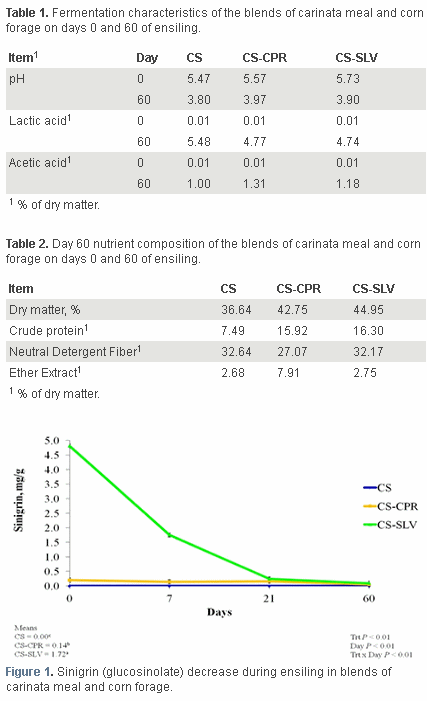Carinata Meal Ensiled With Corn: Effects of fat content on fermentation & glucosinolate degradation
Published: December 7, 2016
By: Karla Rodriguez-Hernandez 1, Jill Anderson 1, Mark Berhow 2 and Alvaro Garcia 3.
/ 1 Dairy Science Department, South Dakota State University; 2 USDA Agricultural Research Service; 3 SDSU Extension Agriculture & Natural Resources Program Director.
Background
Carinata (Brassica carinata) is a new oilseed that shows great potential for the Midwest. This oilseed has been selectively bred for high oil concentration ideal for biofuels and bio-oil production. Carinata meal is the co-product resulting from the oil extraction of the seeds. This meal has high protein content (36-48% crude protein), highly degradable in the rumen, and with a total digestibility of the protein a comparable to soybean and linseed meals (Lawrence et al., 2015).
Carinata meal however has high concentration of a glucosinolate, known as sinigrin. Its potential use as a feedstuff is limited to 10% or less of cattle diets because a possible reduction in palatability result of the bitter taste caused by glucosinolate degradation. Glucosinolates also could cause health problems related to the thyroid gland function causing growth issues. Decreasing the glucosinolate content would allow for more flexibility in the use of carinata meal in cattle diets. Recent research by the SDSU Dairy and Food Science department demonstrated that ensiling carinata meal with alfalfa haylage or corn silage was an effective method to reduce the glucosinolate content without affecting silage fermentation (Rodriguez-Hernandez et al., 2016).
Two methods used to extract oil from carinata seeds are solvent extraction and cold-press extraction which result in different oil content in the meal (2.5% vs. 20% of ether extract). As cold-press is a lower cost extraction method with less chemical use compared to solvent extraction, it may be more attractive processing method for local carinata growers. However, the high fat content in the carinata meal from cold-press extraction could affect fermentation and potentially decrease the degradation of glucosinolates when cold-pressed carinata meal is ensiled with forages. Thus the objective of recent research was to test if the meal fat content or extraction method affected silage fermentation and glucosinolate degradation.
Methodology
To test our theory, three treatments were tested 1) corn silage (CS); 2) CS blended with solvent-extracted carinata meal (CS-SLV); and 3) CS blended with cold-pressed carinata meal (CS-CPR). Both blends of carinata meal and CS were 25:75 on a dry matter basis. Each of the three treatments was packed at 16 lbs of DM/ft3 in PVC micro-silos in triplicate for 0, 7, 21 and 60 days of ensiling.
The fermentation profiles of the three treatments results were within normal ranges for corn silage (see Table 1). The fiber content of CS-CPR decreased, but no change in fiber content was observed in the CS-SLV blend compared with CS. Crude protein content for CS-SLV and CS-CPR blends increased 2.2 times compared with CS (see Table 2). Sinigrin (glucosinolate) content decreased almost 95% immediately after blending in CS-CPR compared to the original meal, however CS-SLV had a slower rate of glucosinolate degradation (see Figure 1). Compared with the original meal by day 60 sinigrin content decreased 99.7% in CS-CPR and 99.4% in CS-SLV (see Figure 1).
Conclusion
Ensiling either solvent extracted or cold-pressed extracted carinata meals with corn silage decreased glucosinolate content without major detriment to silage fermentation. Animal feeding studies with the ensiled blends are still needed to determine impacts of compounds left from glucosinolate breakdown on palatability and animal performance. However, ensiling shows good potential as an on-farm method to decrease glucosinolates in carinata meal regardless of fat content and extraction method.

Acknowledgements
This research was funded by the South Dakota Oilseed Initiative with support by the SDSU Ag Experiment Station.
This article was originally published in IGrow (igrow.org), a service of SDSU Extension.
References
- Lawrence, R. and J. Anderson. 12/21/2015. Camelina meal and carinata meal: potential protein sources for dairy cattle.
- Rodriguez-Hernandez, K., J. Anderson, and M. Berhow. 05/16/2016. Ensiling carinata meal with forage: an option to decrease the glucosinolate content.
Related topics:
Authors:



Recommend
Comment
Share
27 de octubre de 2019
My point is the rancidity of oil in this meal because the plant is high in oil, other is fat metabolism and ruminal digestion. Thanks.
Recommend
Reply

Would you like to discuss another topic? Create a new post to engage with experts in the community.









